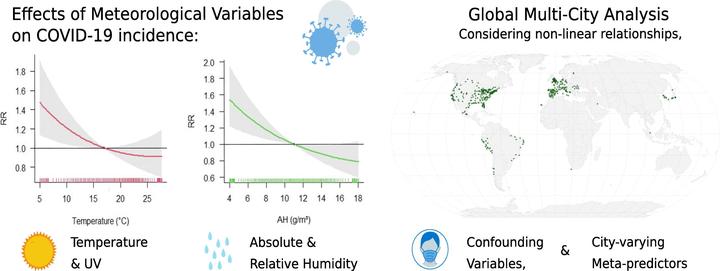The association of COVID-19 incidence with temperature, humidity, and UV radiation – A global multi-city analysis

Abstract
Background and aim: The associations between COVID-19 transmission and meteorological factors are scientifically debated. Several studies have been conducted worldwide, with inconsistent findings. However, often these studies had methodological issues, e.g., did not exclude important confounding factors, or had limited geographic or temporal resolution. Our aim was to quantify associations between temporal variations in COVID-19 incidence and meteorological variables globally. Methods: We analysed data from 455 cities across 20 countries from 3 February to 31 October 2020. We used a time-series analysis that assumes a quasi-Poisson distribution of the cases and incorporates distributed lag non-linear modelling for the exposure associations at the city-level while considering effects of autocorrelation, long-term trends, and day of the week. The confounding by governmental measures was accounted for by incorporating the Oxford Governmental Stringency Index. The effects of daily mean air temperature, relative and absolute humidity, and UV radiation were estimated by applying a meta-regression of local estimates with multi-level random effects for location, country, and climatic zone. Results: We found that air temperature and absolute humidity influenced the spread of COVID-19 over a lag period of 15 days. Pooling the estimates globally showed that overall low temperatures (7.5 °C compared to 17.0 °C) and low absolute humidity (6.0 g/m³ compared to 11.0 g/m³) were associated with higher COVID-19 incidence (RR temp =1.33 with 95%CI: 1.08; 1.64 and RR AH =1.33 with 95%CI: 1.12; 1.57). RH revealed no significant trend and for UV some evidence of a positive association was found. These results were robust to sensitivity analysis. However, the study results also emphasise the heterogeneity of these associations in different countries. Conclusion: Globally, our results suggest that comparatively low temperatures and low absolute humidity were associated with increased risks of COVID-19 incidence. However, this study underlines regional heterogeneity of weather-related effects on COVID-19 transmission.